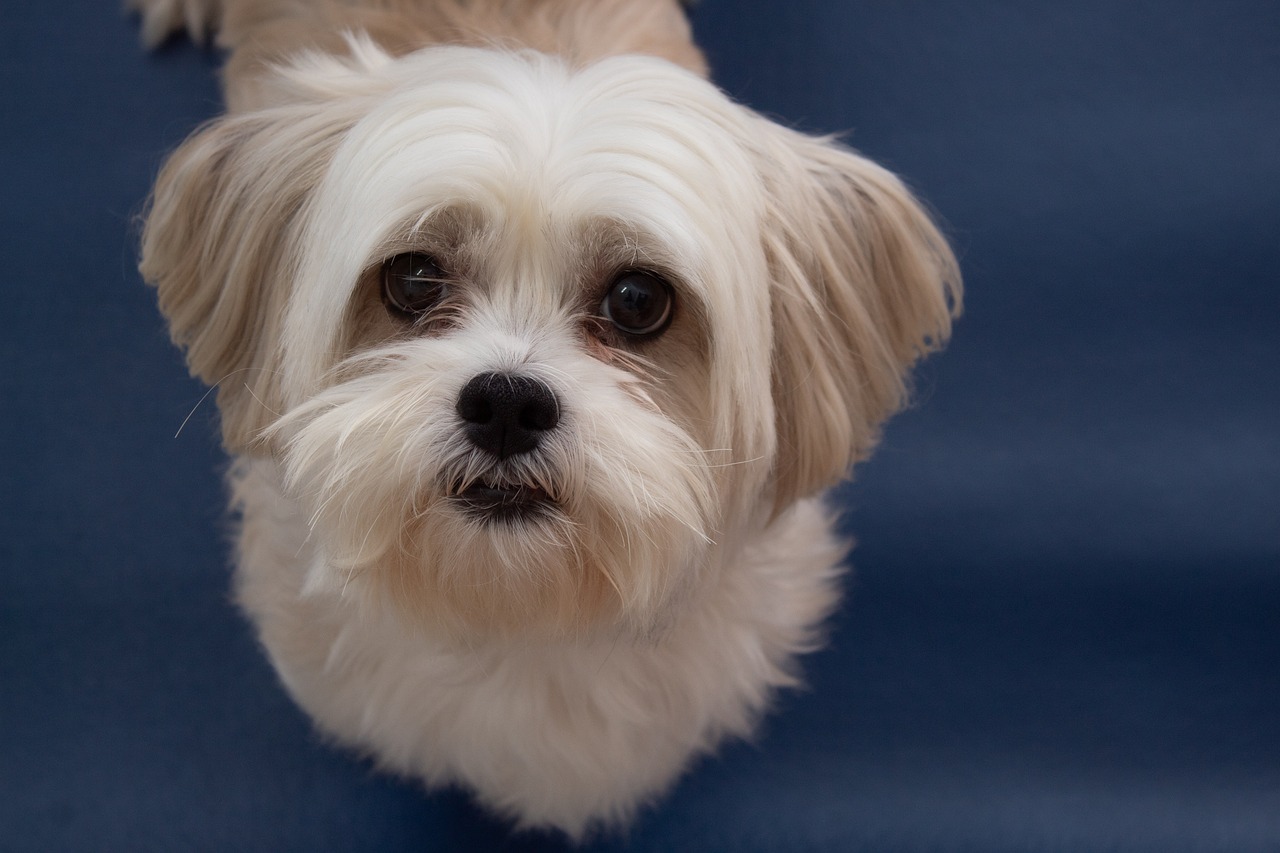Why Lhasa Apsos Are Great Family Pets
When it comes to finding the perfect family pet, the Lhasa Apso stands out as a fantastic choice. These adorable little dogs are not just cute; they bring a unique blend of qualities that make them ideal companions for families of all shapes and sizes. Imagine a furry friend that’s not only loyal but also playful and affectionate—sounds perfect, right? Lhasa Apsos have a personality that fills homes with joy and laughter, making them a beloved member of the family. Their charming nature and ability to bond with family members create a warm atmosphere, turning any house into a home.
One of the most appealing aspects of Lhasa Apsos is their temperament. They are known for being friendly and affectionate, often forming strong attachments to their human companions. This breed has a playful side that can keep both kids and adults entertained for hours. Their loyalty is unmatched, making them protective of their family while still being gentle and loving. These dogs thrive on companionship and enjoy being part of family activities, whether it’s curling up on the couch during movie night or joining the kids in the backyard for a game of fetch.
Another reason Lhasa Apsos are great family pets is their adaptability. These small dogs fit comfortably into various living environments, from cozy apartments to spacious homes. Their size means they don’t require a massive yard to run around in, which is perfect for families who may not have a lot of space. They can easily adjust to the rhythm of your household, whether you’re bustling about with kids or enjoying a quiet evening at home. This adaptability makes them a practical choice for families living in urban settings as well as those in suburban or rural areas.
Of course, every dog has its needs, and Lhasa Apsos are no exception. While they have moderate energy levels, they still require regular exercise to stay happy and healthy. Daily walks and playtime are essential for keeping their spirits high. Think of it this way: just like we need our daily dose of movement to feel good, so do our furry friends! Incorporating walks into your family routine not only benefits the dog but also provides a fantastic opportunity for bonding. Imagine strolling through the neighborhood together, your Lhasa Apso trotting happily beside you, tail wagging in delight.
Engaging in playtime activities is another fun way to keep your Lhasa Apso stimulated. They love interactive games that challenge their minds and bodies. Whether it’s a game of tug-of-war or a simple game of hide and seek, these activities foster a deeper connection between your family and your pet. Plus, it’s a great way to keep the kids active while teaching them responsibility and empathy towards animals.
Now, let’s talk about grooming. Lhasa Apsos are known for their stunning long coats, which can be a sight to behold. However, maintaining that beautiful fur requires a bit of commitment. Regular grooming sessions are essential to keep their coats healthy and free from tangles. Families should be prepared to invest time in brushing their Lhasa Apso’s coat, but it can also be a rewarding bonding experience. Picture this: you and your child sitting together, gently brushing your dog’s luxurious fur while sharing stories and laughter. It’s moments like these that create lasting memories.
In conclusion, Lhasa Apsos are more than just pets; they are family members who bring joy, love, and companionship into our lives. Their friendly temperament, adaptability to various living environments, and moderate exercise needs make them a perfect fit for families. With a little dedication to grooming and training, these delightful dogs can become the heart of any household. So if you’re considering adding a furry friend to your family, look no further than the charming Lhasa Apso!
- Are Lhasa Apsos good with children? Yes, Lhasa Apsos are generally good with children and can be playful companions for them.
- How often do Lhasa Apsos need grooming? They require regular grooming, ideally every few days, to maintain their long coats.
- Do Lhasa Apsos need a lot of exercise? They have moderate exercise needs and enjoy daily walks and playtime.
- Are Lhasa Apsos good for apartment living? Yes, their small size makes them suitable for apartment living.

Temperament and Personality
Lhasa Apsos are not just dogs; they are cherished family members with a personality that can light up any room. Known for their friendly and affectionate nature, these little furballs have a way of making everyone feel loved and included. Imagine coming home after a long day, and your Lhasa Apso greets you with a wagging tail and a joyful bark, as if to say, "Welcome back! I've missed you!" This kind of loyalty and warmth is what makes them truly special.
One of the standout qualities of Lhasa Apsos is their playful demeanor. They have an innate ability to bring joy to any gathering, often engaging in playful antics that can leave everyone in stitches. Their curiosity about the world around them drives them to explore, making playtime a delightful experience for both the dog and the family. Whether it's chasing after a ball or engaging in a playful tug-of-war, Lhasa Apsos thrive on interaction and love to be the center of attention.
But it's not just their playfulness that makes them great family pets; it's their strong bonds with family members. Lhasa Apsos are known to form deep attachments, often choosing a favorite person in the household. This loyalty can be incredibly rewarding, as they will stand by your side through thick and thin. Their affectionate nature means they enjoy cuddling on the couch or snuggling in bed, providing comfort and companionship.
It's important to note that while Lhasa Apsos are generally friendly, they can also exhibit a bit of a protective streak. They are natural watchdogs, alerting their families to any unusual sounds or movements. This protective instinct, combined with their affectionate nature, makes them not only great companions but also reliable guardians of the home. Families can feel secure knowing that their Lhasa Apso is always on the lookout for them.
In summary, the temperament and personality of Lhasa Apsos make them ideal family pets. Their affection, playfulness, and loyalty create a loving atmosphere in any home. If you're looking for a dog that will not only bring joy but also become a beloved member of your family, a Lhasa Apso might just be the perfect fit!

Size and Space Requirements
Lhasa Apsos are small, sturdy dogs that typically weigh between 12 to 18 pounds and stand about 10 to 11 inches tall at the shoulder. This compact size makes them incredibly versatile when it comes to living environments. Whether you reside in a cozy apartment or a spacious house, a Lhasa Apso can comfortably adapt to your lifestyle. Their size is like that of a charming little package filled with love and personality, making them perfect for families who may not have a lot of extra space.
One of the remarkable aspects of Lhasa Apsos is their ability to thrive in various settings. Unlike larger breeds that require expansive yards or outdoor spaces, these little furballs can get their exercise and playtime in smaller areas. This adaptability means that even if you live in a bustling city, your Lhasa Apso can still enjoy a happy and fulfilling life. Imagine having a dog that can enjoy the vibrant energy of urban living while still being perfectly content in a more confined space!
However, it's essential to remember that while Lhasa Apsos are small, they still need their own little corner of the world to feel secure and comfortable. A designated area with a cozy bed, some toys, and perhaps a blanket can work wonders for their sense of belonging. Families should consider setting up a small space where their Lhasa Apso can retreat when they need a break from the hustle and bustle of family life.
When it comes to their exercise needs, Lhasa Apsos require daily walks and playtime, but these can easily be accommodated in smaller living spaces. A quick stroll around the block or some interactive playtime inside can keep them happy and healthy. In fact, many Lhasa Apso owners find that their dogs are just as content with a few minutes of play in the living room as they are with a long run in the park. This makes them ideal companions for families with busy schedules or limited outdoor space.
In summary, Lhasa Apsos are the perfect blend of small size and big personality, making them suitable for a variety of living arrangements. Their adaptability means they can flourish in both apartments and larger homes, provided they receive the love, attention, and exercise they need. So, if you're considering adding a furry friend to your family, a Lhasa Apso might just be the perfect fit!
- Are Lhasa Apsos good with children? Yes, Lhasa Apsos are known for their affectionate nature and can be great companions for children, especially when socialized early.
- How much exercise do Lhasa Apsos need? They require moderate exercise, including daily walks and playtime, to keep them happy and healthy.
- Do Lhasa Apsos shed a lot? Lhasa Apsos have a long coat that requires regular grooming, but they are considered low-shedding dogs.
- Are they easy to train? With consistent training and positive reinforcement, Lhasa Apsos can learn basic commands and tricks relatively easily.
Exercise Needs
When it comes to keeping your Lhasa Apso happy and healthy, understanding their is paramount. Now, don't let their small size fool you; these little furballs have a playful spirit that requires regular activity. While they aren't marathon runners, they do enjoy their daily doses of exercise to stay fit and mentally stimulated. Think of it like this: just as we feel energized after a brisk walk or a fun game, our furry friends thrive on similar experiences. So, how can you make sure your Lhasa Apso gets the right amount of exercise?
First and foremost, daily walks are a must! These walks serve multiple purposes—they provide essential physical activity while also allowing your pup to explore the world around them. Imagine your Lhasa Apso strutting down the street, tail wagging, soaking in all the sights and sounds. It's not just exercise; it's an adventure! Aim for at least a 30-minute walk each day, which can be broken up into shorter sessions if needed. This routine not only keeps them fit but also strengthens the bond between you and your furry companion.
In addition to walks, engaging in playtime activities is vital for your Lhasa Apso's overall well-being. These dogs love to play! Whether it's a game of fetch in the backyard or a fun tug-of-war session with their favorite toy, interactive play helps stimulate both their mind and body. You can also introduce them to puzzle toys that challenge their problem-solving skills. This kind of mental exercise is just as important as physical activity. After all, a tired dog is a happy dog!
To give you a clearer picture, here's a quick breakdown of their exercise needs:
| Activity | Duration | Frequency |
|---|---|---|
| Daily Walks | 30 minutes | Once or twice a day |
| Playtime (Fetch, Tug-of-War) | 15-20 minutes | Daily |
| Mental Stimulation (Puzzle Toys) | 10-15 minutes | Daily |
By incorporating these activities into your daily routine, you'll create a well-rounded exercise plan that caters to your Lhasa Apso's needs. Remember, the goal is to keep them engaged and happy, which ultimately leads to a more harmonious family life. So, grab that leash, toss a toy, and get ready to enjoy some quality time with your furry friend!
- How much exercise does a Lhasa Apso need? Lhasa Apsos typically require about 30 minutes of exercise daily, which can include walks and playtime.
- Can Lhasa Apsos live in apartments? Yes, their small size makes them well-suited for apartment living, as long as they get regular exercise.
- What types of activities can I do with my Lhasa Apso? You can engage them in walks, fetch, tug-of-war, and provide puzzle toys for mental stimulation.
Daily Walks
Daily walks are not just a routine for Lhasa Apsos; they are an essential part of their overall well-being. These charming little dogs thrive on physical activity, and taking them out for walks offers a myriad of benefits that go beyond just exercise. Picture this: a sunny afternoon, you and your Lhasa Apso strolling through the neighborhood, enjoying the fresh air and each other's company. It's not just a walk; it's an opportunity for bonding, exploration, and fun!
When it comes to the ideal duration for these walks, Lhasa Apsos generally require about 30 minutes to an hour of exercise each day. This can be broken down into two shorter walks, making it easier to fit into a busy family schedule. The key is to keep these walks engaging. Lhasa Apsos are naturally curious, so varying your route can stimulate their minds. They love to sniff around and discover new scents, which is a natural behavior for dogs.
Moreover, walks can be an excellent way for families to incorporate some structure into their day. Establishing a routine where everyone participates in the walks can enhance the bond between family members and their furry friend. You might even consider using a doggy backpack for your Lhasa Apso, allowing them to carry a small load. This not only makes them feel involved but also adds a bit of extra exercise to their routine!
For those families with young children, daily walks can turn into a delightful family activity. Kids can take turns holding the leash, teaching them responsibility and nurturing their connection with the pet. Just remember to supervise younger children closely, as Lhasa Apsos, being small and sometimes a bit stubborn, might get excited and pull on the leash. Keeping the walks fun and safe is crucial!
In addition to physical benefits, daily walks contribute significantly to a Lhasa Apso's mental health. Dogs are social creatures, and walks expose them to various sights, sounds, and smells, helping them become well-adjusted and confident. Regular outdoor adventures can also reduce anxiety and behavioral issues, making your home a happier place for everyone.
To sum it up, daily walks are a vital aspect of a Lhasa Apso's life. They offer a chance to bond, explore, and stay healthy. So, lace up your shoes, grab that leash, and make those daily walks a cherished part of your family's routine!
- How often should I walk my Lhasa Apso? - Ideally, aim for at least one walk per day, lasting 30 minutes to an hour.
- Can I take my Lhasa Apso to the dog park? - Yes! Socializing them with other dogs can be beneficial, but ensure they are comfortable with new environments.
- What should I bring on walks? - Always carry water for your dog, especially on warm days, and consider bringing some treats for training opportunities during the walk.
Playtime Activities
When it comes to keeping your Lhasa Apso entertained, the options are as varied as their personality! These little bundles of joy thrive on interactive play, which not only keeps them physically active but also stimulates their sharp minds. Imagine your Lhasa Apso darting around the living room, tail wagging furiously as they chase after a squeaky toy or a rolling ball. Engaging in playtime activities is essential for building a strong bond between your family and your furry friend, and it can be an absolute blast!
One of the most enjoyable ways to engage with your Lhasa Apso is through fetch. This classic game is not just for larger breeds; Lhasa Apsos love to chase after toys, and it provides them with a great workout. Choose a soft ball or a plush toy that’s easy for them to carry in their mouth. Just make sure to throw it in a safe area where they can run freely without any obstacles. You might be surprised at how quickly they learn to bring it back to you, turning a simple game into a delightful routine.
Another fantastic activity is hide and seek. This game is not only fun but also helps to enhance your dog's problem-solving skills. Start by having your Lhasa Apso stay in one room while you hide in another. Once you're hidden, call their name and watch as they use their nose to track you down. The excitement of finding you will undoubtedly lead to joyous tail wags and happy barks, making it a win-win for both of you!
Don't forget about training games, which can be an excellent way to combine playtime with learning. Teaching your Lhasa Apso new tricks or commands can be incredibly rewarding. Use treats as incentives, and keep the sessions short and fun to maintain their attention. You can even turn it into a mini competition within the family, where everyone takes turns teaching the dog a new trick. This not only helps your dog learn but also fosters teamwork and laughter among family members.
Lastly, consider incorporating agility training into your playtime routine. Setting up a mini obstacle course in your backyard or living room can be a thrilling challenge for your Lhasa Apso. Use items like cones, tunnels, and small jumps to create a fun course. This type of activity not only keeps them physically fit but also mentally stimulated, as they learn to navigate the obstacles. Plus, watching them zoom through the course is bound to bring smiles and laughter to your family.
Overall, playtime activities are crucial for the happiness and well-being of your Lhasa Apso. They provide an opportunity for exercise, mental stimulation, and bonding with your family. So grab those toys, clear some space, and get ready for some fun-filled moments with your furry companion!
- How often should I play with my Lhasa Apso? Aim for at least 30 minutes of interactive play each day to keep them happy and healthy.
- What toys are best for Lhasa Apsos? Soft toys, squeaky balls, and interactive puzzle toys are great choices for engaging their interest.
- Can Lhasa Apsos play with children? Yes! Lhasa Apsos are generally good with children, but supervision is always recommended to ensure gentle play.
- How can I tell if my Lhasa Apso is bored? Signs of boredom include excessive barking, chewing on furniture, or a lack of interest in playtime.
Grooming Requirements
When it comes to grooming, Lhasa Apsos are like the divas of the dog world, flaunting their long, luxurious coats that can make anyone swoon. But with great beauty comes great responsibility! These adorable pups require regular grooming to keep their fur looking fabulous and to maintain their overall health. If you're considering adding a Lhasa Apso to your family, it's essential to understand the grooming needs that come with this breed. Think of grooming as a bonding experience; it's not just about keeping them tidy but also about spending quality time together.
To keep their coats in tip-top shape, Lhasa Apsos need to be brushed at least two to three times a week. This helps to prevent mats and tangles that can easily form in their long hair. If you let it go too long, you might find yourself wrestling with a furry ball of knots, which can be a bit of a nightmare for both you and your pup! A good quality slicker brush or a pin brush works wonders for their coat. Additionally, a comb can help you get through any stubborn tangles that may arise.
Bathing is another crucial aspect of grooming. Lhasa Apsos should be bathed every four to six weeks, or more frequently if they get particularly dirty. Use a gentle dog shampoo that won't irritate their skin. After a bath, it's essential to thoroughly dry their coat, as damp fur can lead to skin issues. Some families even opt for professional grooming services every few months to keep their Lhasa Apso looking pristine. This can be a great way to ensure that their coat is maintained properly, especially if you're pressed for time.
Here’s a quick overview of the grooming schedule you might consider:
| Grooming Task | Frequency |
|---|---|
| Brushing | 2-3 times a week |
| Bathing | Every 4-6 weeks |
| Professional Grooming | Every 2-3 months (optional) |
Don't forget about their ears, eyes, and teeth! Regularly check and clean their ears to prevent wax buildup, which can lead to infections. Their eyes may require occasional wiping to remove tear stains, which are common in the breed. And let's not overlook dental hygiene; brushing their teeth a few times a week can help prevent dental issues down the line. After all, a healthy Lhasa Apso is a happy Lhasa Apso!
In summary, grooming a Lhasa Apso is not just a chore; it’s an opportunity to bond with your furry friend. By committing to a regular grooming routine, you’ll ensure that your Lhasa Apso remains not only beautiful but also healthy and happy. So, grab your brushes, put on some music, and enjoy the grooming process—it can be a fun and rewarding experience for both you and your pet!
- How often should I groom my Lhasa Apso?
It's recommended to brush them 2-3 times a week and bathe them every 4-6 weeks. - Can I take my Lhasa Apso to a professional groomer?
Yes, many families opt for professional grooming every few months to keep their dog looking its best. - What tools do I need for grooming?
A slicker brush, comb, dog shampoo, and dental care supplies are essential for proper grooming. - Are there specific grooming challenges with Lhasa Apsos?
Matting and tangling can be common due to their long hair, so regular brushing is crucial.

Training and Socialization
Training and socialization are essential components of raising a well-adjusted Lhasa Apso. These adorable little dogs, with their charming personalities and fluffy coats, thrive on positive reinforcement and consistent guidance. Think of training as building a bridge between you and your furry friend; it establishes trust and communication. Without this bridge, misunderstandings can arise, leading to behavioral issues. So, how do we ensure that our Lhasa Apso grows up to be a well-mannered member of the family? It all starts with early training and socialization.
One of the first steps in training your Lhasa Apso is teaching them basic commands. Simple commands like sit, stay, and come not only provide structure but also create a foundation for a strong bond between you and your pup. Imagine being able to call your dog and have them respond promptly; it’s not just a matter of obedience, but a testament to the trust you’ve built together. Consistency is key here. Use the same words and gestures every time, and reward your dog with treats or praise to reinforce their good behavior. Over time, these commands will become second nature to your Lhasa Apso.
Socialization is equally important. It’s crucial that your Lhasa Apso is exposed to a variety of environments, people, and other pets during their formative months. This exposure helps them develop confidence and reduces the likelihood of fear-based reactions later in life. Think of socialization as a puppy’s passport to the world; the more stamps they collect, the more comfortable they’ll be navigating different situations. Take your Lhasa Apso to parks, introduce them to friendly dogs, and invite people over to your home. The more experiences they have, the better equipped they’ll be to handle new situations with ease.
To make the most out of socialization, consider these techniques:
- Start Early: The earlier you begin socializing your puppy, the better. Aim for the critical socialization window, which is typically between 3 and 14 weeks of age.
- Positive Experiences: Ensure that every new experience is positive. Use treats and praise to create a happy association with new people, places, and sounds.
- Gradual Exposure: Introduce your Lhasa Apso to new experiences gradually. Start with less intimidating situations and gradually work your way up to more complex environments.
Remember, patience is vital during both training and socialization. If your Lhasa Apso is hesitant or scared, don’t force them; instead, take a step back and allow them to approach the situation at their own pace. Celebrate small victories, and soon you’ll have a confident, well-mannered companion who’s ready to take on the world by your side.
1. How long does it take to train a Lhasa Apso?
Training can vary based on the individual dog, but with consistent practice, you can expect to see progress within a few weeks. Remember, every dog learns at their own pace.
2. What is the best age to start socializing my Lhasa Apso?
The ideal time to start socializing your Lhasa Apso is between 3 to 14 weeks of age. This is when they are most receptive to new experiences.
3. Are Lhasa Apsos difficult to train?
Lhasa Apsos are intelligent and can be trained successfully with positive reinforcement methods. However, they can also be a bit stubborn, so patience and consistency are key.
4. How much exercise does a Lhasa Apso need?
Lhasa Apsos require moderate exercise. Daily walks and playtime are essential to keep them happy and healthy. Aim for at least 30 minutes of activity each day.
Basic Commands
Teaching your Lhasa Apso basic commands is not just about instilling discipline; it's about creating a stronger bond between you and your furry friend. Imagine this: every time you say "sit," your dog plops down obediently, looking up at you with those big, soulful eyes. It's not just a command; it's a moment of connection. Starting with simple commands like "sit," "stay," and "come" can set the foundation for a well-behaved pet who knows what is expected of them.
To make the learning process effective, it's essential to use positive reinforcement. This means rewarding your Lhasa Apso with treats, praise, or playtime whenever they follow a command correctly. Think of it as a fun game where both of you are winners! For instance, when your dog successfully sits on command, shower them with excitement and a tasty treat. This encourages them to repeat the behavior, knowing that good things come when they listen.
Here’s a simple breakdown of some basic commands you can teach your Lhasa Apso:
- Sit: A fundamental command that helps establish control and can be a precursor to more advanced training.
- Stay: This command teaches patience and is essential for safety in various situations.
- Come: Vital for ensuring your dog returns to you when called, especially during outdoor adventures.
Consistency is key when training your Lhasa Apso. Use the same words and tone every time you give a command, and practice regularly. Just like a child learns through repetition, your dog will pick up these commands more quickly if you make training a daily part of your routine. Consider setting aside a few minutes each day for training sessions. These can be fun and engaging, turning into a delightful part of your day.
Additionally, it’s beneficial to integrate training into everyday activities. For example, when it's time for dinner, ask your Lhasa Apso to sit before placing their food bowl down. This not only reinforces the command but also helps them learn patience. Over time, these commands will become second nature to your dog, leading to a more harmonious home life.
In conclusion, teaching basic commands to your Lhasa Apso is an enriching experience that fosters communication and strengthens your relationship. With patience, consistency, and a sprinkle of fun, you can transform your playful pup into a well-mannered companion. Remember, every command learned is a step towards a happier, healthier family life with your furry friend!
Q: How long does it take to train a Lhasa Apso?
A: Training duration varies by dog, but with consistent practice, you can see progress within a few weeks. Some commands may take longer, so patience is essential!
Q: Are Lhasa Apsos stubborn when it comes to training?
A: Lhasa Apsos can be a bit independent, which might come off as stubbornness. However, with positive reinforcement and engaging methods, they can be trained successfully.
Q: What is the best age to start training my Lhasa Apso?
A: It's best to start training as early as possible, ideally when they are puppies. However, older dogs can learn too, so don't worry if you have an adult Lhasa Apso!
Socialization Techniques
Socializing your Lhasa Apso is not just about introducing them to other dogs; it’s about creating a well-rounded, confident companion who feels comfortable in various environments. Think of it as giving your furry friend a passport to explore the world! The earlier you start this process, the better. Puppies are like sponges, soaking up every new experience, so capitalize on that by exposing them to different sights, sounds, and smells.
One effective technique is to take your Lhasa Apso on short trips to different locations. This could be as simple as a stroll through the local park, a visit to a pet-friendly café, or even a family gathering. Each outing can help them learn how to behave in new situations and around other people and animals. Remember, the goal is to create positive associations, so make sure these experiences are enjoyable. Bring along some of their favorite treats and toys to reinforce good behavior.
Another important aspect of socialization is meeting new people. Encourage friends and family to visit your home and interact with your Lhasa Apso. You can also take them to dog training classes, where they can meet other dogs and their owners in a controlled environment. This not only helps with their social skills but also strengthens the bond between your dog and your family. Just like humans, dogs thrive on relationships!
Consistency is key in socialization. Make it a part of your daily routine. For instance, you can schedule playdates with other dogs or visit pet stores where they can meet new people. The more experiences your Lhasa Apso has, the more confident they will become. Just be sure to monitor their reactions; if they seem overwhelmed, it’s okay to take a step back and try again later. Think of socialization like building a muscle; it takes time and patience to develop, but the rewards are well worth it.
To summarize, effective socialization techniques include:
- Taking short trips to various locations.
- Encouraging interactions with new people.
- Attending training classes for structured socialization.
- Incorporating socialization into your daily routine.
By following these techniques, your Lhasa Apso will not only become a well-adjusted pet but will also bring joy and companionship to your family. Remember, a well-socialized dog is a happy dog!
Q1: How early should I start socializing my Lhasa Apso?
A1: It's best to start socializing your Lhasa Apso as early as possible, ideally between 3 to 14 weeks of age. This is when they are most receptive to new experiences.
Q2: What if my Lhasa Apso is shy or fearful?
A2: Take it slow! Gradually introduce them to new experiences and environments, and always ensure that these situations are positive. Patience is key.
Q3: How often should I socialize my dog?
A3: Aim for daily interactions. Consistency helps reinforce their confidence and adaptability in different situations.
Q4: Can I socialize my adult Lhasa Apso?
A4: Absolutely! While it may take a bit more time, adult dogs can still learn and benefit from socialization. Start with low-stress environments and gradually increase exposure.
Frequently Asked Questions
- What is the temperament of Lhasa Apsos?
Lhasa Apsos are known for their friendly and affectionate nature. They are playful, loyal, and often form strong bonds with their family members. Their personality makes them excellent companions for both children and adults.
- Do Lhasa Apsos require a lot of space?
No, Lhasa Apsos are small dogs that can adapt well to various living environments, including apartments and larger homes. They don't require excessive space to roam, making them suitable for families in different settings.
- How much exercise do Lhasa Apsos need?
While Lhasa Apsos have moderate energy levels, they benefit from daily walks and playtime. Regular exercise is essential for their physical and mental well-being, and it can easily be incorporated into family routines.
- What grooming needs do Lhasa Apsos have?
Lhasa Apsos have long, beautiful coats that require regular grooming. Families should be prepared to invest time in brushing and maintaining their dog's coat to keep it healthy and free from mats.
- Are Lhasa Apsos easy to train?
Training Lhasa Apsos can be a rewarding experience. They respond well to consistent training and can learn basic commands with patience and positive reinforcement. Early socialization is also crucial to help them develop good behavior.
- How can I socialize my Lhasa Apso?
To socialize your Lhasa Apso, introduce them to different environments, people, and other pets gradually. This exposure helps them become well-adjusted companions and builds their confidence in various situations.



















